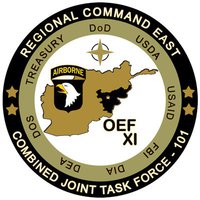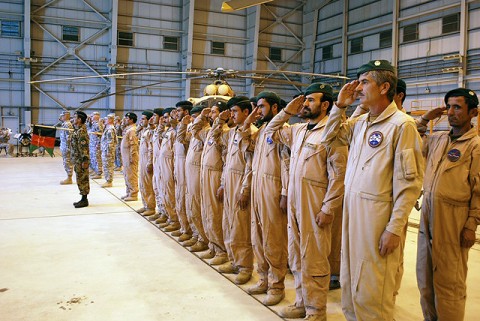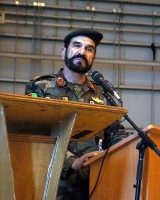Written by U.S. Army Sgt. Monica K. Smith
3rd Combat Aviation Brigade, Task Force Falcon
 Bagram Airfield, Afghanistan – A formation of U.S. Soldiers stood alongside a formation of Afghan soldiers during a ceremony transferring authority of two academies from U.S. to Afghan forces October 9th at Kabul International Airport.
Bagram Airfield, Afghanistan – A formation of U.S. Soldiers stood alongside a formation of Afghan soldiers during a ceremony transferring authority of two academies from U.S. to Afghan forces October 9th at Kabul International Airport.
The two academies, the Crew Chief Academy and the Air Assault Academy, were part of four academies created by the 3rd Combat Aviation Brigade, Task Force Falcon, designed to train, coach and advise Afghan National Security Forces.

The ceremony included speeches from U.S. Army Brig. Gen. Warren Phipps, deputy commanding general (support) for the 101st Airborne Division, Afghan Brig. Gen. Mohammed Barat, Kabul Wing commander of the Afghan Air Force, and U.S. Army Col. Don Galli, TF Falcon commander, from Haverton, PA.

“Today’s transfer of authority for the Air Assault and Crew Chief Academies does not mean the end to our relationship,” said Galli. “It is too strong for that. I believe our friendship will endure because it is absolutely essential we continue to work as brothers to defeat the enemies of Afghanistan.”
Both academies had four classes each, with a combined total of 173 graduates. The Crew Chief Academy had students from both the Afghan Air Force and the first Afghan flight medics, whereas the Air Assault Academy had students from both the Afghan Air Force and the Afghan commandos.
U.S. Army Chief Warrant Officer 3 Christopher Hinkle, from Pittsburgh, headed the program as the TF Falcon Combined Action Program manager and also served as the senior instructor of the Air Assault Academy. U.S. Army 1st. Sgt. Christopher Wood, from Lancaster, PA, served as the senior instructor for the Crew Chief Academy, however the lead instructor of the Crew Chief Academy rotated for each class.
 “It’s a great feeling to watch us transfer authority from U.S. leadership to Afghan leadership,” said U.S. Army Sgt. Matthew West, crew chief with Company A, TF Knighthawk, 3rd CAB, TF Falcon, from Vicksburg, MS, who also served as an instructor during one of the Crew Chief Academy classes. “That was the whole point of the training; that we would be able to train them to the point where their proficiency matched ours, and the Afghans could begin instructing their own, allowing us to leave a much smaller footprint here. It’s all about equipping the Afghan forces. This ceremony is just one step in the process.”
“It’s a great feeling to watch us transfer authority from U.S. leadership to Afghan leadership,” said U.S. Army Sgt. Matthew West, crew chief with Company A, TF Knighthawk, 3rd CAB, TF Falcon, from Vicksburg, MS, who also served as an instructor during one of the Crew Chief Academy classes. “That was the whole point of the training; that we would be able to train them to the point where their proficiency matched ours, and the Afghans could begin instructing their own, allowing us to leave a much smaller footprint here. It’s all about equipping the Afghan forces. This ceremony is just one step in the process.”
During the last two classes of both academies, former students returned to serve as instructors, and the academies served a dual purpose of training students and training the trainer.
 The end goal of the Combined Action Program is to also transfer the authority of the remaining two academies, the Flight Medic Academy to the Kabul Wing Afghan Air Force, and the Close Combat Attack Academy to the National Afghan Army Corps, however dates have not been set. Hinkle said any additional goals will be dependent on the Afghans.
The end goal of the Combined Action Program is to also transfer the authority of the remaining two academies, the Flight Medic Academy to the Kabul Wing Afghan Air Force, and the Close Combat Attack Academy to the National Afghan Army Corps, however dates have not been set. Hinkle said any additional goals will be dependent on the Afghans.
“It is up to them to continue to run the academies,” said Hinkle. “We hope they will continue steady classes for each academy to continue to increase and enhance their capabilities to secure and protect their country.”


